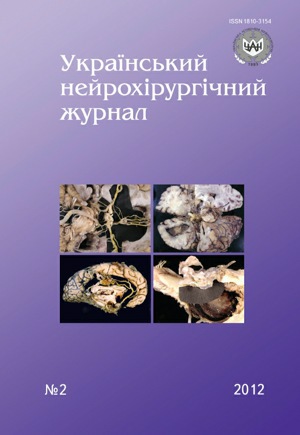Microsurgical removal of intramedullary arteriovenous malformations
DOI:
https://doi.org/10.25305/unj.59049Keywords:
intramedullary arteriovenous malformation, treatment resultsAbstract
Introduction. Intramedullary arteriovenous malformations (IAVM) demand close attention, because they are severe vascular pathology of the spinal cord, which quickly leads to profound neurological deficits. To clarify the results of malformations’ direct surgical excision, the data of patients’ examination and treatment in period 1998–2012 years were analyzed.
Materials and methods. Treatment results of 52 patients with IAVM that have been removed or disabled by open microsurgical procedures were analyzed.
Results. Immediately after surgery in 43 of 52 patients transient worsening of neurological symptoms was observed. At 3 months after surgery neurological symptoms were not worse than before operation. Further significant or partial regression of preoperative neurologic symptoms were observed in 48 patients in 3–24 months after surgery. In 4 patients initial neurological symptoms did not change.
Conclusions. Today IAMV microsurgical removal is quite dangerous, but there are no more effective methods for their neurosurgical treatment.
References
1. Spetzler R, Detwiler P, Riina H, Porter R. Modified classification of spinal cord vascular lesions. Journal of Neurosurgery: Spine. 2002;96(2):145-156. [CrossRef] [PubMed]
2. Boström A, Krings T, Hans F, Schramm J, Thron A, Gilsbach J. Spinal glomus-type arteriovenous malformations: microsurgical treatment in 20 cases. Journal of Neurosurgery: Spine. 2009;10(5):423-429. [CrossRef] [PubMed]
3. MacFarlane M, Burn P, Evison J. Excision of high and mid cervical spinal cord arteriovenous malformations by anterior operation. Journal of Clinical Neuroscience. 2005;12(1):71-79. [CrossRef] [PubMed]
4. Corkill R, Mitsos A, Molyneux A. Embolization of spinal intramedullary arteriovenous malformations using the liquid embolic agent, Onyx: a single-center experience in a series of 17 patients. Journal of Neurosurgery: Spine. 2007;7(5):478-485. [CrossRef] [PubMed]
5. Ohata K, Takami T, El-Naggar A et al. Posterior approach for cervical intramedullary arteriovenous malformation with diffuse-type nidus. Journal of Neurosurgery: Spine. 1999;91(1):105-111. [CrossRef] [PubMed]
6. Hall W, Oldfield E, Doppman J. Recanalization of spinal arteriovenous malformations following embolization. Journal of Neurosurgery. 1989;70(5):714-720. [CrossRef] [PubMed]
7. Ushikoshi S, Hida K, Kikuchi Y, Iwasaki Y, Miyasaka K, Abe H. Treatment of intramedullary arteriovenous malformations of the spinal cord. Interv Neuroradiol. 2000 Nov 30;6 Suppl 1:203-7. [PubMed]
8. Tai PA., Tu YK, Liu H M. Surgical treatment of spinal arteriovenous malformations: vascular anatomy and surgical outcome. Journal-Formosan Medical Association. 2001;100(6):389-396.
Downloads
Published
How to Cite
Issue
Section
License
Copyright (c) 2012 Eugene Slynko, Alexander Zolotoverkh, Iyad Al-Kashkish, Artur Ermoliev

This work is licensed under a Creative Commons Attribution 4.0 International License.
Ukrainian Neurosurgical Journal abides by the CREATIVE COMMONS copyright rights and permissions for open access journals.
Authors, who are published in this Journal, agree to the following conditions:
1. The authors reserve the right to authorship of the work and pass the first publication right of this work to the Journal under the terms of Creative Commons Attribution License, which allows others to freely distribute the published research with the obligatory reference to the authors of the original work and the first publication of the work in this Journal.
2. The authors have the right to conclude separate supplement agreements that relate to non-exclusive work distribution in the form of which it has been published by the Journal (for example, to upload the work to the online storage of the Journal or publish it as part of a monograph), provided that the reference to the first publication of the work in this Journal is included.









